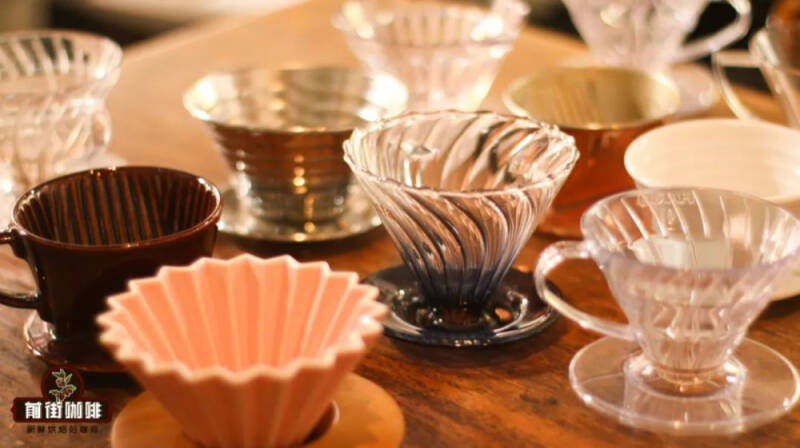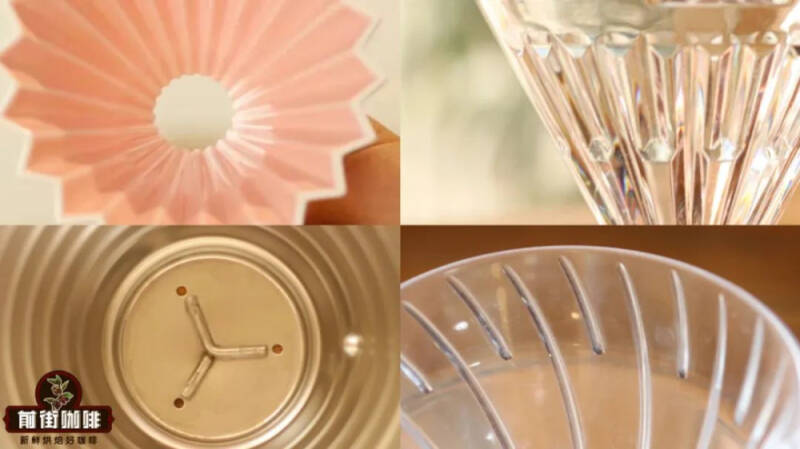There are so many brewing filter cups for hand-brewed coffee, what's the difference? What is the diversion bone?
In yesterday's article, Qianjie said: most of my friends initially chose the filter cup based on its functionality. For example: "this filter cup can make the coffee made cleaner", "this filter cup can make more mellow coffee", "the coffee made by this filter cup has a higher sweetness" and so on.

These extraction characteristics are changed around the structure of the filter cup, and their difference is that after changing part of the structure, a completely different extraction effect is formed. So today, Qianjie will analyze in detail how the structure of the filter cup affects the extraction!
The role of the filter cup no matter what the shape of the filter cup, the main emphasis on the role of there are two points: conductivity, and launching speed. The two are reflected in the distribution of the diversion bone and the size of the launching hole, respectively.
The guiding bone can be the wall of the filter cup, or the protruding lines at the bottom of the cup, or the grooves directly recessed like the ice pupil filter cup and the cross star filter cup. These lines or grooves will support the filter paper and create a certain gap, which we call the "diversion groove". The diversion trough has a main function: to guide the direction of hot water exudation and to increase the space in which hot water can seep out.

If there is no diversion slot, then the filter cup is at best a funnel to support the filter paper (as was the case with the first version of the fan-shaped filter cup designed by Melitta), and the water can only permeate down gravity. We can imagine a Kono without a guide bone, or a Chemex coffee pot. When the filter paper is completely fitted, the water can flow only a small part of the hole at the bottom. The area that allows water to pass through this field is very small. In addition to being occupied by coffee powder, there may be fine powder blocking part of the hole. As a result, the water seeps out very slowly (it will directly pass the slow speed of extraction)! Therefore, a diversion trough is needed to change the path of water and increase the area that can seep out.
The design of the diversion groove is varied, and the traditional one is the vertical design! Filter cups such as Kono and Origami are the users of this design. They use vertical guide bones of different lengths to support the filter paper to make room for water flow! The longer the diversion bone, the more space there is for water to seep out quickly. On the other hand, the flow rate of the part of the diversion bone that is not involved will be slower, and the powder layer located in that part will be in a state of immersion extraction.
The diversion trough, such as the V60 filter cup, is composed of short and long spiral guide bones, which change the direction of water flow that should have perpendicular downward into a spiral flow along the guide bone, so that hot water can flow rapidly at the same time. Coffee can also be evenly extracted.
There are also some special filter cups whose diversion grooves are concave out of the wall of the filter cup from the inside to the outside, such as the ice pupil filter cup of the protagonist of yesterday's article, or the cross star infinite filter cup, the purpose of which is also to create gaps and allow more space for water to flow.
After the hole has finished talking about the diversion trough, we will talk about the hole. The size and number of holes is an important design that determines the flow speed. Its design needs to cooperate with the diversion groove, both of which are indispensable.
The world's first filter cup, designed by Melitta, is a trapezoidal filter cup with multiple diversion bones. Even if this filter cup has a lot of diversion bones, but because it has only one hole and is very small, the flow speed is very slow and over-extraction events occur frequently!
Therefore, this was caught by the Kelita company to "learn from" the opportunity to launch a three-hole trapezoidal filter cup, greatly improving the speed of water seepage! Therefore, the bigger / more holes in the filter cup, the more space the water can seep out!
Therefore, not every filter cup with a diversion groove will be like the V60, the launching speed will be faster! It's just that they need this design to control the water seepage rate within a reasonable time, so as to avoid excessive extraction!
The common materials of material filter cup are resin, ceramic, metal and glass, which have little influence on extraction, which mainly lies in the thermal conductivity of the material. But if it is not in the case of preheating with a large amount of hot water before cooking, it will not make much difference. At best, it will increase the effect of heat preservation.
Therefore, when we understand the main design concept of the filter cup, we can roughly judge the difference between the filter cup and other filter cups by its appearance. In this way, when you buy it, you won't be confused by the appearance of the colorful filter cup. Now many manufacturers have launched the filter cup with valve version one after another. On the basis of the original filter cup, an adjustable and controllable switch is added. The increase of this function not only lowers the entry threshold for beginners, but also gives the old players more playability! After we have played through the conventional filter cup, it will also be a good pastime to try the Smart Cup version of the filter cup.
-END-
Front Street Cafe
No. 10 Baoqian street, Yandun road, Dongshankou, Yuexiu district, Guangzhou, Guangdong province
Important Notice :
前街咖啡 FrontStreet Coffee has moved to new addredd:
FrontStreet Coffee Address: 315,Donghua East Road,GuangZhou
Tel:020 38364473
- Prev

When hand-brewing coffee is injected into three stages, do you need to wait for the flow to finish before filling?
Qianjie in the three-stage cooking often said: "when the water level is about to hit bottom, then inject the next section of water!" This can not help but arouse the curiosity of the broad masses of small friends: why should we inject water when it is running dry, instead of injecting water after it dries? What is the difference between the two? Good question! The best proof.
- Next

What do baristas do when they have nothing to do?
▲ click follow | Daily boutique coffee culture magazine coffee workshop debug machine, make coffee, wash cups, clean, inventory materials, chat with different types of guests. This is the daily work of baristas, which seems to be slow and fulfilling. But in fact, guests don't come to the store all the time.
Related
- What effect does Italian American coffee with filter paper have? Will coffee taste better if it is put on filter paper at the bottom of the powder bowl?
- What is the color difference in coffee beans? What are the characteristics of honey processed coffee beans? Why are the anaerobically treated coffee beans uneven in color?
- How does novice Xiaobai quickly get started and make coffee? Newbies learn to make coffee by hand and share the specific steps and process process!
- Costa tea has a shelf life of 100 years?! Expert: Unable to verify
- It's a huge uproar! American milk addition was rejected by Manner employees?!
- Mocha pot coffee bean recommendations| How fine and how much powder should be used for grinding? What parameter ratios do I need to use to make milk with Mocha pot coffee?
- What are the characteristics of the world's top ten coffee beans treated with Costa Rica honey? How to make black honey kadura from Tarazhu Pilon Processing Plant taste good?
- How to make deep-roasted coffee? What grinding water temperature does authentic Jamaica Blue Mountain No. 1 coffee use to brew it well?
- Selected high-grade rose summer coffee flavor tasting guide Why Panama rose summer has the aroma of flowers and fruits
- What equipment does a novice Xiaobai need to buy to learn to make coffee? Filter cup electronic scale bean grinder manual flushing pot purchase guide

